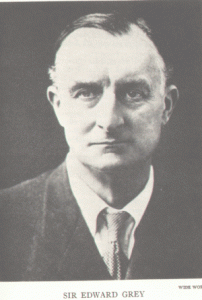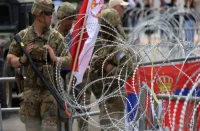The centennial anniversary of the First World War is a time for sober reflection and deep thought about the causes and consequences of this human tragedy. It has been quipped that hindsight is 20/20, but being so far removed from the actual event itself nowadays, it appears as though hindsight through today’s polarized polemics is nearsighted. History is being reinterpreted for short-term political points, forgetting that the British intent of the original conflict was for a long-term and farsighted transformation of the European (at the time, recognized as “global”) power arrangement. Of course, not everything turned out as intended, and dark horses emerged to offset these carefully crafted plans and/or reap undeserved dividends. No matter that one hundred years has already passed, the same geostrategic objective is the same – the seafaring powers must utilize all methods (including intrigue and massive bloodletting) to prevent the continental powers from colluding against them. The continuum of history eerily shows that shadows of the past still hang over the head of the future, and the thematic lessons leading up to and following World War I still dangerously ring true today.
The series is written in two parts: themes and consequences. Each part begins with a general overview of the discussed topic before comparing its relevancy from then and now. A concluding lesson sums up every part.
Nikolay Starikov’s writings on World War I serve as the basis for the historical claims about British diplomacy during this time. For brevity, not all details pertinent to the highlighted topics can be addressed, but they most certainly are able to be expanded upon.
PART I:THEMES
Geopolitical Framing
It is commonly said that “geography is destiny”, and to a very large extent, geographic location is a strong determinant of action. Alfred Mahan and Halforth Mackinder understood this very well at the turn of last century. Mahan published “The Influence of Sea Power Upon History” in 1890, which argued that sea power is key to controlling the land. Mackinder took this a step further in 1904, writing in “The Geopolitical Pivot of History” that sea power’s obvious geographic limitations necessitate a strong control over the Heartland in order to dominate Eurasia. This was originally understood as Central Asia, but it has shifted over time.
Why It Mattered Then:

The UK and Germany were engaged in a fierce naval armaments race up until the eve of World War I. Although the British Navy was supreme, Germany was clearly a rising threat to this hegemony. Additionally, Germany and Austria-Hungary were the masters of Central Europe and Russia controlled the Heartland (essentially ‘winning’ the Great Game). Russian historian Nikolay Starikov brilliantly argues that the UK, using its centuries-long diplomatic expertise (and cunningness) in great power balancing, instigated Germany and Russia into war after the events of Sarajevo in order to destroy its two greatest foes (in different Eurasian theaters) in one fell swoop.
Why It Matters Today:
Brzezinski, writing in “The Grand Chessboard” in 1997, cautions American decision makers about the possibility (then distant, today more realistic) of a German-Russian alliance that would isolate America from Europe, and thus, collapse America’s Eurasian strategy. Accommodating for this geopolitical reality, it now makes sense why there is so much Western guilt mongering against Germany for supposedly starting World War I – the objective is to keep Germany and Russia divided and prevent their future policy coordination. The spate of Color Revolutions is aimed solely at penetrating the former Soviet Heartland and removing Russia from the Great Power game. On the naval front, the US is trying to bait China into a disastrous collision course with its Southeast Asian neighbors over disputed maritime territories.
Lesson:
The combination of sea and land power, properly coordinated and applied across Eurasia, is the basic formula for global control. A moment’s glance at the map of American overseas naval and military deployments easily proves Mahan and Mackinder’s theories without any words necessary. Because geography cannot be changed, these ideas will continue to guide the US and any other aspiring global hegemon. In today’s world, the US has merged Brzezinski’s Eurasian Balkans concept with Gene Sharp’s mass agitation tactics (abetted by social media networks) to conceive the weapon of Color Revolutions to accomplish just that.
The Hobbesian Alliance System
Countries enter into military alliances with one another for some kind of perceived benefit, which may vary depending on the actor. Even if such alliances do not de-jure mandate mutual military defense, if the known perception is that it does entail such a commitment, then the parties’ reputations and prestige may strongly be at stake if they do not carry through with their expected obligation. The larger alliance systems grow, the more convoluted they become, eventually ensnaring all that are weaved into the web. Large-scale wars can thus start based on miscalculation or peripheral events.

Why It Mattered Then:
The obligational perceptions surrounding alliances played an important part in the long fuse leading up to World War I, as Starikov writes that “up to the beginning of WWI, the Entente alliance was not framed by treaty!” Clearly, there was always a “way out”, but due to duplicitous British diplomacy (also duly elaborated upon by Starikov in his works), the situation was carefully framed for Germany and Russia as though there was no alternative. Once activated, the stringy alliance complex exponentially multiplied until most of the entire continent (and the Middle East via the Ottoman Empire) were engulfed in total war. A relatively trite event in the grand scheme of contemporaneous politics (a political assassination in the continental periphery) led to an all-out conflagration in its core.
Why It Matters Now:
After the Cold War, NATO continued to grow unabated, gobbling up the remnants of the Warsaw Pact and part of the former Yugoslavia and Soviet Union. Although mutual military defense is not legally binding in NATO (Article 5 does not explicitly stipulate military assistance, leaving it up to each member state to make that decision on its own), the perception is that it is. This means that the US and its cohorts may get dangerously drawn into a regional conflict in order to save face. Turkey’s provocative actions in Syria or its failed plans for a false-flag attack there should send alarm bells ringing for the rest of the world. The same can be said for Poland and Lithuania, also NATO members, in regards to their plans to create a joint brigade with non-member Ukraine. Clearly, one middle power in a major alliance can draw the rest of its twenty-seven members into a disastrous calamity. Leaving NATO aside, the US has a mutual defense agreement with Japan, whom it has been egging on to provoke China. The security guarantees provided by America to Israel and Saudi Arabia could also easily suck it into a regional war with Iran.
Lesson:
Military alliances are a type of nearly sacrosanct agreement that states enter into with one another, placing their prestige and the lives of their citizens on the line for their partners. They should not be entered into as a form of political statement. The larger the alliance is, the greater the chance for unintended outbreaks of major war and for middle players to manipulate the other members. It is totally unstable when Obama, in referring to the US, proudly tells the graduating class of West Point that, “From Europe to Asia, we are the hub of alliances unrivaled in the history of nations.” Exceptionally dangerous are so-called “defensive” alliances that only have a track record of offensive military action (e.g. every NATO war). Alliances can complicate the political situation just as much as they can clarify it.
(Distant) Manipulative Balancing Powers
The balance of power and divide and rule concepts are as old as the pages of time, yet equally as old is the knowledge that the more distant the practitioner of these strategies, the less likely they are to be directly affected by the negative consequences of their actions. This makes them more calculating and lethal in the damage potential that they can reap in the targeted theaters. The power of the manipulative balancing state must also be taken into account. If a strong state is manipulating weaker ones, then the risk potential of negative consequences decreases; likewise, once strong states begin manipulating their peers, the risk for negative consequences (even if the states are distant from one another) dramatically increases.
Why It Mattered Then:
The UK had historically been the prima donna of balance of power and divide and rule policies in Europe, and it played this role perfectly in the lead-up to World War I. As outlined by Starikov, UK Foreign Secretary Edward Grey diligently played all the continental powers off against one another in order for his country to reap the anticipated benefits of a continental Hobbesian conflict. The consequences of the war did not exactly pan out as anticipated (as is wont to happen with any grand strategic gambit), but nonetheless, it is important to note the impact of the UK’s interference in the Great War’s genesis. Its vision of European balancing and divide and rule directly contributed to the tragedy, whether advertently or inadvertently.
Why It Matters Now:
The US has replaced the UK as the world’s global balancer and practitioner of divide and rule. Its new policy of Lead from Behind is a euphemism for these practices. It appoints regional allies to carry out what are perceived to be mutually advantageous policies (to the objective advantage of the US’ grand strategy, but only to the subjective advantage of the ‘ally’s’) while Washington supervises and manages events. Turkey and Poland are the prime examples of this policy at work, and the CIA and FBI’s influence over the Kievan junta is yet another application of this. More sinisterly, Color Revolutions can also trace their birth to a (distant) manipulative power trying to manage regional events to its own interest. By globally manipulating multitudes of players simultaneously, a critical risk of mismanagement and unintended consequences arises. This is all the more apocalyptic due to advances in military technology (nuclear weapons, drones, cyber warfare, etc.) that can level the playing field between the manipulating and the manipulated great powers.
Lesson:
(Distant) Manipulative balancing powers paradoxically have both foresight and blindness. They have a certain vision of what global or regional order should look like, yet in order to bring this idea to fruition, many complicated moves must be made in advance. The blindness stems from the fact that when risky gambits of huge consequence are made, unintended consequences of varying nature usually follow, and more than likely, these tend to have some type of disastrous result for some or all of the affected parties. The more distant and strong the manipulative power is, the more likely it will have grandiose (and dangerous) visions of what the future should look like and will actually act on those desires. Even if this type of actor is only manipulating a small or middle power, if the eventual target is a power of equal or near strength, then it is the same as trying to manipulate that said power (e.g. US manipulation of Ukraine to offset Russia). This never leads to peaceful and stable results.














Pingback: The Lessons and Consequences of World War I: Back to the Future? (II) | Oriental Review
Pingback: Lessons and Consequences of World War I: Back to the Future? — Infowars Ireland
Pingback: Back to the Future? : The re-alignment between the US and EU on one side… | YERELCE
Pingback: The Lessons and Consequences of World War I: Back to the Future – aladdinsmiraclelamp
Pingback: The Lessons and Consequences of World War I: Back to the Future? (II) | OrientalReview.org